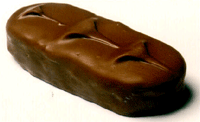Rounded ends to an elongated rectangular chocolate bar
 GvEA, 8 juli 2009, zaak T-28/08, Mars, Inc. tegen OHIM / Ludwig Schokolade GmbH & Co. KG (Nederlandse vertaling nog niet beschikbaar).
GvEA, 8 juli 2009, zaak T-28/08, Mars, Inc. tegen OHIM / Ludwig Schokolade GmbH & Co. KG (Nederlandse vertaling nog niet beschikbaar).
Merkenrecht. Succesvolle nietigheidsprocedure tegen vormmerk ‘Bounty’. Geen onderscheidend vermogen: “As the shape in question, taken as a whole, cannot be sufficiently distinguished from other shapes commonly used for chocolate bars, it does not permit the relevant public immediately and with certainty, without conducting an analytical examination and without paying particular attention, to distinguish the applicant’s chocolate bars from those with a different commercial origin. Accordingly, the shape applied for is itself devoid of any distinctive character in relation to the goods concerned.” Geen inburgering aangetoond voor alle lidstaten.
Onderscheidend vermogen: 31. Secondly, as regards the allegedly distinctive characteristics of the shape in question, relied on by the applicant, it must be stated, first, that an elongated shape is almost intrinsic to a chocolate bar and does not therefore significantly depart from the norm and customs of the relevant sector. Furthermore, the word ‘bar’ itself suggests that the shape of the product it describes is elongated. It is a shape which comes naturally to the mind of the consumer of mass consumption goods such as the goods concerned (see, to that effect, Case T-396/92 Storck v OHIM (shape of a sweet) [2004] ECR II-3821, paragraphs 39 and 42).
32. Secondly, the applicant’s argument that ‘applying rounded ends to an elongated rectangular chocolate bar is in itself unusual in the sector’ must also be rejected. As stated by the intervener, which provides a number of examples in that regard, many chocolate bars available on the market display that combination of elements. Furthermore, the applicant itself admitted in the application and at the hearing that there are other chocolate bars on the market which have a shape similar to that of the mark applied for. The applicant has not however shown in what respect those other goods are merely copies of the mark applied for in the present case.
33. Lastly, as regards the three chevrons on the top of the shape at issue, it must be held that the Board of Appeal was correct to find, in paragraph 26 of the contested decision, that the average consumer of the category of goods concerned will perceive those chevrons, at the most, as decorative elements and not as a sign indicating the commercial origin of the product. The applicant has not established that the relevant consumer would pay particular attention to that characteristic or to the rounded ends to the point of perceiving them as an indication of the commercial origin of the product concerned. As stated by the Board of Appeal, the end user will usually pay more attention to the label on the product or its packaging and the name, image or graphic design displayed thereon than simply to the shape of the product. Furthermore, as the product in question is sold in opaque packaging the consumer will generally see its shape only after having removed that packaging.
34. Consequently, the Board of Appeal showed to the requisite legal standard that none of the characteristics of the shape of the mark at issue, taken alone or combined with the mark’s other characteristics, is distinctive. As the shape in question, taken as a whole, cannot be sufficiently distinguished from other shapes commonly used for chocolate bars, it does not permit the relevant public immediately and with certainty, without conducting an analytical examination and without paying particular attention, to distinguish the applicant’s chocolate bars from those with a different commercial origin. Accordingly, the shape applied for is itself devoid of any distinctive character in relation to the goods concerned.
35. It is apparent from all of the foregoing that the Board of Appeal did not infringe Article 7(1)(b) of Regulation No 40/94. Consequently, the first plea must be rejected as unfounded.
Inburgering: 45. It is also settled case-law that, in order to have the registration of a mark accepted under Article 7(3) of Regulation No 40/94, the distinctive character acquired in consequence of the use of that mark must be demonstrated in the part of the Community where it was, ab initio, devoid of any such character under Article 7(1)(b) to (d) of that regulation (Case C-25/05 P Storck v OHIM [2006] ECR I‑5719, paragraph 83; Case T-91/99 Ford Motor v OHIM (OPTIONS) [2000] ECR II-1925, paragraphs 26 and 27; Case T-402/02 Storck v OHIM (shape of a sweet wrapper) [2004] ECR II-3849, paragraph 78; and judgment of 12 September 2007 in Case T-141/06 Glaverbel v OHIM (texture of a glass surface), not published in the ECR, paragraph 40).
46. In the present case, the Board of Appeal found, in paragraph 32 of the contested decision, that ‘[t]he mark applied for [had] been found to be non-distinctive in the entire Community, which at the filing date of the [applicant’s] trade mark, namely 7 May 1998, consisted of 15 Member States’. It is thus in the entire Community, consisting of the then 15 Member States, that the mark applied for must have acquired distinctive character through use in order to be registrable under Article 7(3) of Regulation No 40/94 (see, to that effect, Case C‑25/05 P Storck v OHIM, paragraphs 81 to 86).
47. Accordingly, the Board of Appeal did not err in requiring evidence of distinctive character acquired through use in the 15 Member States which were part of the Community at the time when the trade mark application was filed.
Lees het arrest hier.


























































































